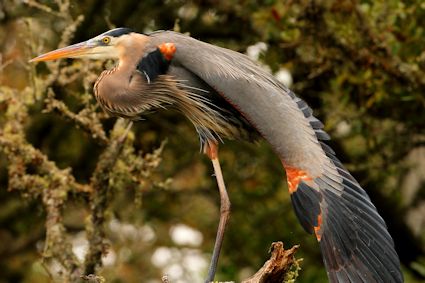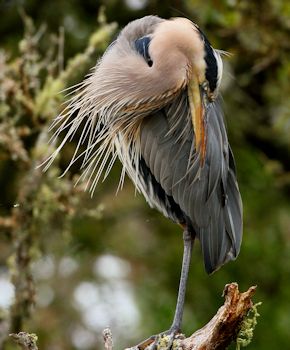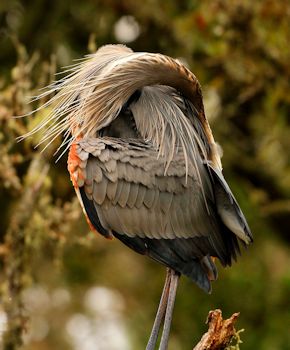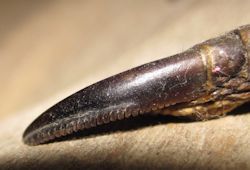 The great blue heron is one of the most widespread and recognizable birds. Like the cardinal and mockingbird, even the most casual observer of wildlife can identify the great blue heron. Photo: Sam Bland The great blue heron is one of the most widespread and recognizable birds. Like the cardinal and mockingbird, even the most casual observer of wildlife can identify the great blue heron. Photo: Sam Bland |
EMERALD ISLE — As I recently finished an early morning jog, the pale light of a new day was beginning to reach out from underneath the horizon and brush away the darkness. In the distant sky, I could barely make out the long, lanky shape of a large bird struggling for traction against a stiff wind. The bird was headed for the leeward protection of a stand of trees with a vacant roosting spot on the bare branches of an ancient decaying live oak.
As it made its landing approach, spindly legs dangled from its body, its long neck, head and bill were stretched out like a spear and its broad wings were a confusion of movement. Its wings then billowed out behind and above the body like a gray parachute causing the big bird momentarily to hover over the branch while its wispy legs and feet delicately reached for purchase. As its feet secured the landing, its enduring neck and head coiled into the shape of an “S” while its generous wings fold away and seem to disappear into its body. The initial awkwardness of this landing was completed with the amazing gracefulness of a dancer.
Supporter Spotlight
Throughout the United States, the great blue heron is one of the most widespread and recognizable birds. Like the cardinal and mockingbird, even the most casual observer of wildlife can identify the great blue heron. Their size alone, standing at over four feet tall, makes them quite conspicuous to even the most oblivious.
In flight, their large bodies look heavy and seem to defy gravity. Yet, they weigh only five or six pounds thanks to their lightweight hollow bones. Even though they are thought of as a coastal bird, they can be found near most fresh and salty bodies of water. At dusk in these habitats, its loud throaty scratching squawk can often be heard as it launches into the air. It is a primal sound that betrays its delicate charm.
 |
 |
 |
| The great blue heron has a secret protective armor known as powder down that will soak up any slime, oil or blood and thus, prevent this muck from fouling their feathers. Photos:Sam Bland | ||
They are masters at hunting, where they may quietly wait to ambush any fish that ventures within range or they may slowly stalk after prey at a glacial pace. They are legendary for their patience. A calm patience that burns with silent intensity in their yellow eyes like a hot golden ember buried deep in the coals of a campfire.
Their prolific fishing abilities led to speculation that they employed a secret weapon to lure fish within striking distance. Fishermen, envious of the great blues fishing prowess, were convinced that their feet emanated a fish attracting oil. So persuaded were the fishermen, to the point that they would coat their fishing lines and bait with the body fat of blue herons to increase their chances of landing a fish. It was also believed that the herons could make their toes squirm as a worm-mimicking decoy. A large part of their diet is fish, but they also feast on shrimp, crabs, frogs, snakes, insects and even small rodents.
The solitary great blue seems to hold sway over most fishing grounds as other birds rarely challenge their territory. This perception is best told in an ancient Native American legend. In much earlier times, both the great blue heron and hummingbird ate fish. Worried that there might not be enough fish available for the both of them, the hummingbird challenged the great blue to a race with the winner gaining all rights to the fish. They would race up a river to a spot where a tree had fallen along the river bank. The first to reach the tree would feast on fish forever. As the race started, the hummingbird darted out of sight up the river as the great blue slowly and deliberately chased after. Each night, the humming bird slept since the great blue was nowhere in sight while the great blue plodded along without rest. The great blue eventually overtook the hummingbird while it smugly slept without a tad of concern and reached the fallen tree in first after four days of flying. It now eats all the fish it wants while the hummingbird must be satisfied with the nectar of flowers.
Supporter Spotlight
 The toe nail of a great blue heron is serrated like to teeth of a comb to ease cleaning of feathers. Photo: Sam Bland |
Much of the food they devour is coated with a protective layer of sticky slime that splatters on their feathers when their mighty bill clamps down on a meal. The slime has the potential to matt their feathers together and to diminish their effectiveness as insulation and inhibit their flight. But the great blue has a secret protective armor known as powder down that will soak up any slime, oil or blood and thus, prevent this muck from fouling their feathers. Powder down feathers, which also help keep the bird warm, always grow. As their ends become tattered and frazzled, a powder-like keratin substance is created that the heron applies to its feathers with their long sturdy bill. After the powder comes in contact with any contaminants, they can be easily removed as the bird preens its feathers using specially adapted toes on its feet that act like a comb. The toe nail is actually serrated like the teeth on a comb.
There are ancient tales of the magical abilities of powder down. It was once thought that a great blue could, to see fish at night, light up the waters by casting about the powder down upon the surface of the water. As the down came in contact with the water it would sparkle and twinkle like the stars, making it much easier to see the fish swimming about.
All their preening keeps them clean, prim and proper, creating the dapper regal image of the great blue heron. While most cultural and folklore legends cast the great blue in a favorable light, their beauty has also been viewed as a sign of vanity. The great blue heron has been seen as a messenger and as an omen of good luck. But its wisdom, intelligence and judgment has earned it the honor of representing one of the clans of the Iroquois Nation.
The great blue heron that had settled down on the branch immediately began to preen its feathers and lay on a new layer of powder down. I could even see a few of the white flakes drift into the air. I went a short distance to my home and returned with a camera. It postured and posed like a model at the end of a cat walk; it was my avian muse. As it finally rested, burying its bill and most of its head into a pile of fluffy breast feathers, our coastal ambassador of elegance and grace was bathed in the warm light of a new day.







